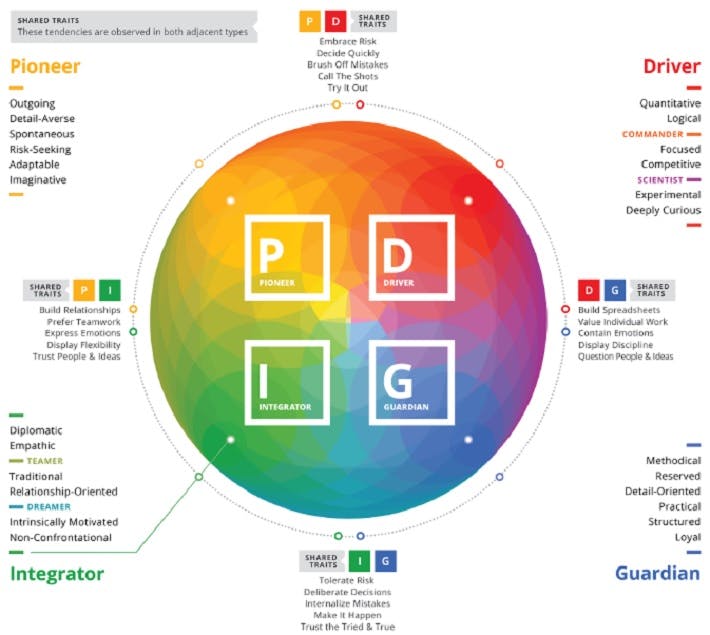Are you satisfied with the performance of your team? Are they producing the right results individually and collectively?
Every day, I interact with senior executives struggling to tackle a variety of business challenges, dissatisfied with their own answers to these fundamental questions. I’ve noticed that as diverse as their challenges are, they often share a common problem: Ineffective team dynamics leading to suboptimal engagement, productivity and performance. And typically, at the heart of this problem lies a lack of understanding about diverse working styles.
Our team at Deloitte has spent years researching work styles to shed light on how individuals prefer to make decisions, solve problems, work with others and even respond to stress. As a result, we developed the Business Chemistry system to help people identify with, and recognize, four core patterns of behaviors:
- Pioneers, who seek possibilities and spark energy and imagination;
- Drivers, who like a challenge and generate momentum;
- Guardians, who crave stability and bring order and rigor; and
- Integrators, who desire connection and bring teams together.
 When managers and co-workers identify their own Business Chemistry styles and observe the styles of others, it can help flag potential conflicts between individuals and within teams and may inform strategies to more effectively adapt and manage these styles day to day.
When managers and co-workers identify their own Business Chemistry styles and observe the styles of others, it can help flag potential conflicts between individuals and within teams and may inform strategies to more effectively adapt and manage these styles day to day.
Here are just three ways to help manage diverse work styles in the office based on our findings:
1. Embrace the Power In Productive Friction
Conflicting work styles are common in the workplace. While you may prefer a certain way of solving problems or coping with pressures at work, your coworker – or manager – is likely to have a different approach. That’s no surprise; whatever your primary style is, the math says that the majority of the population will likely have one that’s different from yours. This can be most obvious, and painful, when a person sits at the other end of the behavioral spectrum from where you are; indeed 40% of people say their opposites are the most challenging group to work with.
Don’t be discouraged by the friction. Opposite styles can complement each other and result in a more balanced, higher performing team. Putting the time and effort into learning how to work with teammates with opposing work styles and preferences can create a resilient partnership in the long run.
2. Make Room for All Voices
It’s common for teams to be dominated by a particular work style, which limits the value of having diverse perspectives. Leadership roles are often occupied by styles that are more assertive and vocal (the Pioneers and Drivers who make up 65% of today’s C-suite, according to our research). Unfortunately, once ideas and decisions start “cascading” in one direction, it can be difficult to disrupt momentum and open the process to others. Encouraging those least likely to speak up to assert themselves and take leadership early on can give them a chance to influence the direction of the conversation before the avalanche carries everyone away.
The more introverted types on a team may be less quick to speak up and can inadvertently be left out unless a conscious effort is made to seek out their input. We often find that those who are the quietest can also be the most critical, creative thinkers. Building an environment that fosters a collaborative dynamic can go a long way in encouraging everyone to participate.
3. Cultivate a New View Of Diversity
There is commonly a lot of discussion about the power of diversity in business today, but often times those discussions focus on gender, age, and other demographic designations. We suggest that working styles can provide an insightful, additional lens to this discussion. Teams can benefit from a balance of perspectives, and those without may be exposed to blind spots and limitations as a result.
These tips have been effective in my own working relationships. For example, Dr. Suzanne Vickberg, who leads research on my team, is a self-proclaimed Guardian. She likes organization and consistency and feels stressed when she needs to come up with an answer on the spot. I, on the other hand, love spontaneity and new challenges, but feel deflated by detailed processes. We’ve learned how to work together effectively and play to one another’s strengths — Suzanne knows that I am focusing on the big picture, and I trust that Suzanne has considered every detail. But beyond just valuing the complementary nature of our strengths together, we have also put in place structures to help ensure Suzanne can fully contribute.
Our team is fast-paced and dynamic. Taking into account Suzanne’s work preferences, I carved out a role for her that is buffered from that chaos – and she has responded with amazing productivity. In our meetings, we create and stick to clear agendas, with pre-reads that allow her to come ready to share her perspectives versus feeling forced to make things up on the fly, but with room for me to explore a few tangents. This combination of strategies has resulted in an environment that suits each of us individually, while letting us work together to create common success.
How do your own experiences reflect some of the scenarios outlined? Have you or your team members felt encumbered by working styles of others and existing team dynamics? Do you lead a team prone to cascades or certain individuals consistently dominating discussions? If so, I’d love to hear from you directly on your experiences and some methods that have worked for you.
